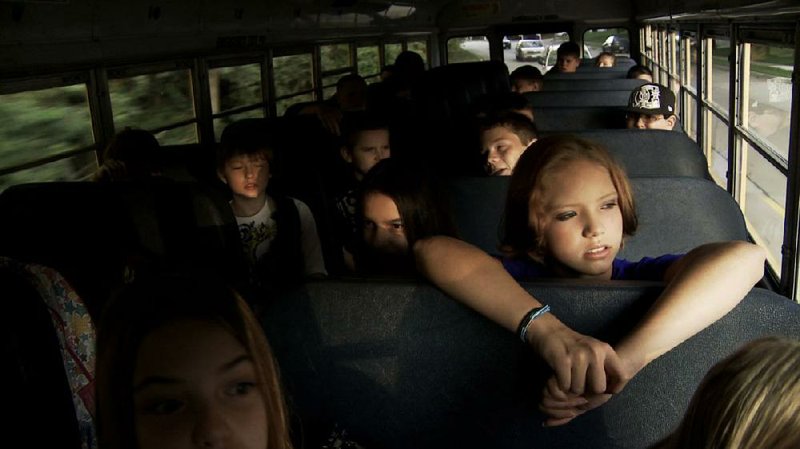LITTLE ROCK — I normally don’t use this space to advocate that you see - or refrain from seeing - any particular movie. I figure that you’re all big boys and girls, and that you can make up your own minds about the entertainment products you download.
But this week, I’m going to request you make every effort to see a documentary that isn’t even opening in Arkansas this week (and maybe not next week, though it should arrive here soon). More importantly, if you’re a parent, I want to ask you to make your kids see this movie.
It’s called Bully, and it was directed by Lee Hirsch and Alicia Dwyer and I saw it at the Tribeca Film Festival nearly a year ago (when it was called The Bully Project). It was picked up for distribution by The Weinstein Co. (TWC) at that festival.
Ironically, the day it was bought the filmmakers were part of a festival panel discussing alternative distribution models. The assumption was they wouldn’t be able to get the film into theaters, so they were planning to organize community screenings in church basements and school auditoriums, even homes of interested individuals. But Harvey Weinstein thought the film deserved a theatrical release, a promotional budget and an awareness campaign. I agree.
I want to reserve the right to write about the considerable artistic virtues of Bully when it opens. But in a way, it doesn’t much matter whether Bully is a good movie (although it is); what matters is that it’s a morally important movie.
It is, as you might have heard or guessed, a movie about the way some kids treat other kids in schools. It’s about the casual violence suffered by children deemed different by their peers. It is heartbreaking, devastating and - if you have ever spent time in a school - shamefully familiar. It’s a movie that ought to be shown in every classroom in the country.
Unfortunately, the Motion Picture Association of America gave Bully an R rating (for language), which requires children under 17 to be accompanied by a parent or guardian. The MPAA declined to change that rating when TWC appealed.
Now almost everybody who takes movies seriously understands the MPAA’s system for rating movies - G, PG, PG-13, R and NC-17 - is inherently flawed and often silly. Ostensibly designed, according to the MPAA, “to provide parents with advance information so they can decide for themselves which films are appropriate for viewing by their own children,” the ratings often seem arbitrary and bizarre. A wonderful children’s film like Niki Caro’s Whale Rider (2002) was initially saddled with an R rating because of some brief rough language and a glimpse of a bong in the background of one scene.
Though Whale Rider ultimately received a PG-13 rating, even that seems draconian given the overall tone of the film. (There were practical results as well. The rating prevented the distributors from using in their marketing a quotation from critic Roger Ebert to the effect that the film was “for the entire family” because the MPAA obviously didn’t agree.)
NO RATING
TWC then decided to release the movie without a rating. Weinstein publicly contemplated withdrawing from the MPAA and releasing his movies without ratings.
I’m not sure that Weinstein isn’t bluffing, though I’d be rooting for him if he did this. It would be a brave move because many theaters have policies against showing unrated movies - and the National Association of Theatre Owners advises members to treat all unrated movies as NC-17 films, meaning no one under 18 can be admitted even with his parents.
In February, association President and CEO John Fithian sent Weinstein a letter supporting the MPAA’s decision.
“Surveys of America’s parents reflect their very strong concern with the use of harsh language in movies,” Fithian wrote. “The vast majority of parents surveyed have indicated that the type of language used in Bully should receive an automatic ‘R’ rating. You ask us to ignore the preferences of America’s parents and our own ratings rules because of the merit of this movie. Yet were the MPAA and [the National Association of Theatre Owners] to waive the ratings rules whenever we believed that a particular movie had merit ... we would no longer be neutral parties applying consistent standards, but rather censors of content based on personal mores.”
UNEQUAL TREATMENT
This is a cop-out. The MPAA is demonstrably more forgiving toward studio movies than independent films, more tolerant of graphic violence than sex and willing to let men express carnal gratification on screen more vociferously than women.
At best, the MPAA rating board is a crude, cynical and anonymous body that wields incredible power. Restrictive ratings can cost filmmakers millions of dollars. Some national theater chains have heretofore refused to show unrated films.
But Bully is the sort of film that might be able to stand up to the MPAA. AMC Theaters CEO Gerry Lopez has already said that his chain will show the film, even with an “unrated” rating.
“We believe theater owners everywhere will step up and do what’s right for the benefit of all of the children out there who have been bullied or may have otherwise become bullies themselves,” TWC marketing chief Stephen Bruno said in a statement, adding that the company will make the film available to teachers, parents and students nationwide.
Director Hirsch said he would not edit out offensive language for fear of diminishing the film’s impact.
“The small amount of language in the film that’s responsible for the R rating is there because it’s real,” he says. “It’s what the children who are victims of bullying face on most days.”
I don’t know that I’ve ever said this about a movie before, but you need to see Bully. And your kids need to see it.
E-mail:
pmartin@arkansasonline.com www.blooddirtangels.com
MovieStyle, Pages 29 on 03/30/2012
